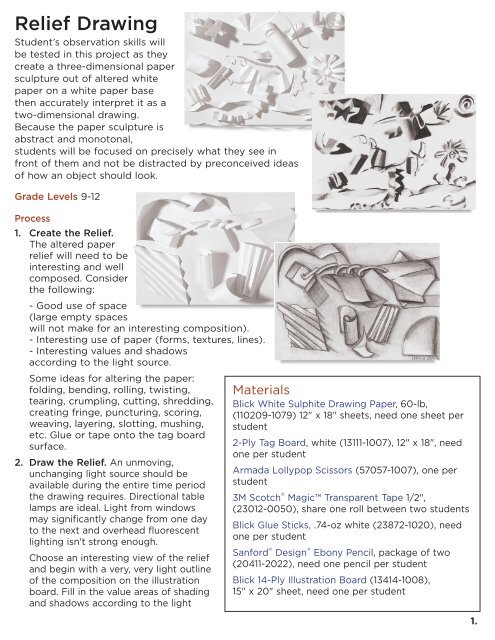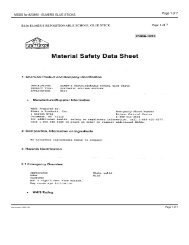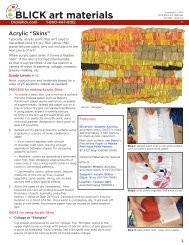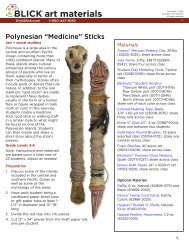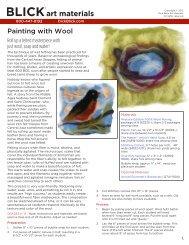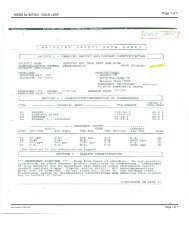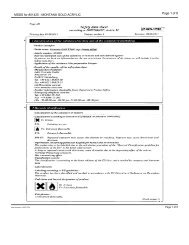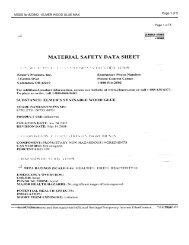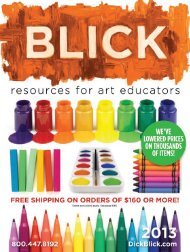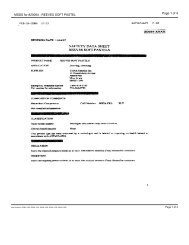Relief Drawing - Dick Blick - Dick Blick Art Materials
Relief Drawing - Dick Blick - Dick Blick Art Materials
Relief Drawing - Dick Blick - Dick Blick Art Materials
Create successful ePaper yourself
Turn your PDF publications into a flip-book with our unique Google optimized e-Paper software.
<strong>Relief</strong> <strong>Drawing</strong><br />
Student’s observation skills will<br />
be tested in this project as they<br />
create a three-dimensional paper<br />
sculpture out of altered white<br />
paper on a white paper base<br />
then accurately interpret it as a<br />
two-dimensional drawing.<br />
Because the paper sculpture is<br />
abstract and monotonal,<br />
students will be focused on precisely what they see in<br />
front of them and not be distracted by preconceived ideas<br />
of how an object should look.<br />
Grade Levels 9-12<br />
Process<br />
1. Create the <strong>Relief</strong>.<br />
The altered paper<br />
relief will need to be<br />
interesting and well<br />
composed. Consider<br />
the following:<br />
- Good use of space<br />
(large empty spaces<br />
will not make for an interesting composition).<br />
- Interesting use of paper (forms, textures, lines).<br />
- Interesting values and shadows<br />
according to the light source.<br />
Some ideas for altering the paper:<br />
folding, bending, rolling, twisting,<br />
tearing, crumpling, cutting, shredding,<br />
creating fringe, puncturing, scoring,<br />
weaving, layering, slotting, mushing,<br />
etc. Glue or tape onto the tag board<br />
surface.<br />
2. Draw the <strong>Relief</strong>. An unmoving,<br />
unchanging light source should be<br />
available during the entire time period<br />
the drawing requires. Directional table<br />
lamps are ideal. Light from windows<br />
may significantly change from one day<br />
to the next and overhead fluorescent<br />
lighting isn't strong enough.<br />
Choose an interesting view of the relief<br />
and begin with a very, very light outline<br />
of the composition on the illustration<br />
board. Fill in the value areas of shading<br />
and shadows according to the light<br />
<strong>Materials</strong><br />
<strong>Blick</strong> White Sulphite <strong>Drawing</strong> Paper, 60-lb,<br />
(110209-1079) 12" x 18" sheets, need one sheet per<br />
student<br />
2-Ply Tag Board, white (13111-1007), 12" x 18", need<br />
one per student<br />
Armada Lollypop Scissors (57057-1007), one per<br />
student<br />
3M Scotch ® Magic Transparent Tape 1/2",<br />
(23012-0050), share one roll between two students<br />
<strong>Blick</strong> Glue Sticks, .74-oz white (23872-1020), need<br />
one per student<br />
Sanford ® Design ® Ebony Pencil, package of two<br />
(20411-2022), need one pencil per student<br />
<strong>Blick</strong> 14-Ply Illustration Board (13414-1008),<br />
15" x 20" sheet, need one per student<br />
1.
Process, continued<br />
source. Shading should define the forms of<br />
the relief and accurately depict the paper<br />
textures - smooth, crumpled, torn, folded,<br />
etc.<br />
Create areas of contrast instead of outlines<br />
defining the edges. Contrast light against<br />
dark, rough against smooth, for example.<br />
There should be no outlines when the<br />
drawing is completed.<br />
Lesson Plan and <strong>Art</strong>work submitted by<br />
Christine Dokolasa, Galesburg, IL<br />
Copyright © 2004 <strong>Dick</strong> <strong>Blick</strong> <strong>Art</strong> <strong>Materials</strong>. All rights reserved.<br />
National Standards<br />
Content Standard #1 — Understanding and applying<br />
media, techniques, and processes<br />
9-12 Proficient<br />
Students apply media, techniques, and processes with<br />
sufficient skill, confidence, and sensitivity that their<br />
intentions are carried out in their artworks<br />
9-12 Advanced<br />
Students initiate, define, and solve challenging visual<br />
arts problems independently using intellectual skills such<br />
as analysis, synthesis, and evaluation<br />
Content Standard #2 — Using knowledge of structures<br />
and functions<br />
9-12 Proficient<br />
Students create artworks that use organizational<br />
principles and functions to solve specific visual arts<br />
problems<br />
9-12 Advanced<br />
Students create multiple solutions to specific visual arts<br />
problems that demonstrate competence in producing<br />
effective relationships between structural choices and<br />
artistic functions<br />
2.


